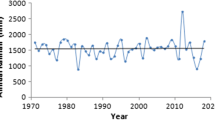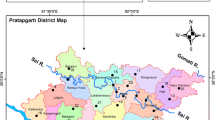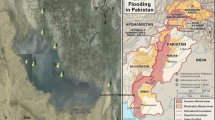Abstract
This paper presents the first assessment study of the surface water quality in the Egyptian Fayoum Governorate (Province). A total of 42 water samples from irrigation and drainage canals as well as Lake Qarun were collected. Major ions, (semi-)metals, nutrients, salinity and microbiological parameters were examined. The results showed that the highest salinities and highest concentrations of Na+, K+, Ca2+, Mg2+, \({\text{SO}}_{4}^{2 - }\), Cl− and δ18O were recorded in Lake Qarun due to up-concentration by evaporation. The highest concentrations of Al, Ba, Cr, Co, Cu, Ni, Fe and Mn were recorded in drainage waters. Tracking the fate of contaminants through sources–sink pathways helped to determine the potential sources of pollution. The highly impacted sites were located close to point sources of pollution such as sewage water treatment plants. Water used as drinking water supply has higher levels of Al and it can be harmful. High levels of microbiological contamination were recorded in irrigation and drainage waters, which therefore might cause water-borne diseases. Improper disposal of sewage or on-site sanitation tank overflowing into these waters is the main cause of microbiological contamination. Drainage and irrigation waters generally have high salinities resulting in soil salinization and degradation. Lake Qarun, a closed saline and alkaline lake, acts as the reservoir for left-over drainage waters. The results show that the lake has a self-cleaning system where most of the (semi-)metals carried by drainage waters are totally adsorbed on the lake sediments. Therefore, Lake Qarun is playing an important role in the environmental balancing in the Fayoum Governorate.









Similar content being viewed by others
References
Abdel Aal T, Ibrahim AM (2013) Studies on the micromorphology of salt-affected soils from El-Fayoum depression, Egypt. In: Shahid SA, Taha FK, Abdelfattah MA (eds) Developments in soil classification, land use planning and policy implications. Springer, The Netherlands, pp 373–392
Abdel Kawy W, Belal A (2012) Spatial analysis techniques to survey the heavy metals content of the cultivated land in El-Fayoum depression. Egypt Arab J Geosci 5:1247–1258
Abdel Wahaab R (2003) Sustainable development and environmental impact assessment in Egypt: historical assessment. Environmentalist 23:49–70
Abdel Wahed MSM, Mohamed EA, El-Sayed MI, M’nif A, Sillanpää M (2014) Geochemical modeling of evaporation process in Lake Qarun. Egypt J Afr Earth Sci 97:322–330
Abd-Elgawad M, Shendi M, Sofi D, Abdurrahman HA, Ahmed A (2013) Geographical distribution of soil salinity, alkalinity, and calcicity within Fayoum and Tamia districts, Fayoum Governorate, Egypt. In: Shahid SA, Taha FK, Abdelfattah MA (eds) Developments in soil classification, land use planning and policy implications. Springer, The Netherlands, pp 219–236
Ali RR, Abdel Kawy WAM (2013) Land degradation risk assessment of El Fayoum depression. Egypt Arab J Geosci 6:2767–2776
APHA (1998) Standard methods for the examination of water and wastewater. American Public Health Association, Washington, DC
Baioumy HM, Kayanne H, Tada R (2010) Reconstruction of lake-level and climate changes in Lake Qarun, Egypt, during the last 7000 years. J Great Lakes Res 36:318–327
Banks D, Parnachev VP, Frengstad B, Holden W, Karnachuk OV, Vedernikov AA (2004) The evolution of alkaline, saline ground- and surface waters in the southern Siberian steppes. Appl Geochem 19:1905–1926
Bodur MN, Ergin M (1994) Geochemical characteristics of the recent sediments from the Sea of Marmara. Chem Geol 115:73–101
Eugster HP, Jones BF (1979) Behavior of major solutes during closed-basin brine evolution. Am J Sci 279:609–631
FAO (1992) FAO irrigation and drainage paper47. FAO, Rome
FAO (2003) Users manual for irrigation with treated wastewater. FAO, TC/D/Y5009F/1/10.03/100
Fathi AA, Flower RJ (2005) Water quality and phytoplankton communities in Lake Qarun (Egypt). Aquat Sci 67:350–362
Gupta G, Abd El-Hamid Z (2003) Water quality of lake Qarun. Egypt Int J Environ Stud 60:651–657
IOB (2010) Drinking water supply and sanitation programme supported by the Netherlands in Fayoum Governorate, Arab Republic of Egypt, 1990–2009. Policy and Operations Evaluation Department, IOB Impact Evaluations 327, Ministry of Foreign Affairs of the Netherlands, pp 1–204
Klein Gebbinck CD, Kim S, Knyf M, Wyman J (2014) A new online technique for the simultaneous measurement of the δ13C value of dissolved inorganic carbon and theδ18O value of water from a single solution sample using continuous-flow isotope ratio mass spectrometry. Rapid Commun Mass Spectrom 28:553–562
Kroetsch D, Wang C (2008) Particle Size Distribution. In: Carter MR, Gregorich EG (eds) Soil sampling and methods of analysis. Taylor & Francis, Boca Raton, pp 713–725
Mageed AAA (1998) Distribution and salinity ranges of zooplankton organisms at El-Fayoum depression (El-Fayoum-Egypt). Egypt J Aquat Biol Fish 2:51–71
Mansour SA, Sidky MM (2002) Ecotoxicological Studies. 3. Heavy metals contaminating water and fish from Fayoum Governorate. Egypt Food Chem 78:15–22
Mansour SA, Sidky MM (2003) Ecotoxicological Studies. 6. The first comparative study between Lake Qarun and Wadi El-Rayan wetland (Egypt), with respect to contamination of their major components. Food Chem 82:181–189
Ongley ED (1999) Water quality management: design, financing and sustainability considerations. In: In Proceedings of the African Water Resources Policy Conference, Nairobi, 26–28 May, The World Bank
Piacentini P (1997) Il Fayyum nell’Antico Regno. in Archeologia e papiri nel Fayyum, Siracusa, 23–24 May, 1996. Atti, Siracusa, pp 21–39
Shendi M, Abdelfattah M, Harbi A (2013) Spatial monitoring of soil salinity and prospective conservation study for Sinnuris District soils, Fayoum, Egypt. In: Shahid SA, Taha FK, Abdelfattah MA (eds) Developments in Soil Classification, Land Use Planning and Policy Implications. Springer, The Netherlands, pp 199–217
Stumm W, Morgan JJ (1996) Aquatic chemistry, chemical equilibria and rates in natural waters. Wiley, New York
Turekian KK, Wedepohl KH (1961) Distribution of the elements in some major units of the earth’s crust. Geol Soc Am Bull 72:175–192
USEPA (1995) Total Colifrom Rule. U S Environmental Protection Agency, Washington, DC EPA 570/9-91-200
USEPA (2009) National Primary Drinking Water Regulations. US Environmental Protection Agency, Washington, DC EPA 816-F-09-004
US Salinity Laboratory (1954) Diagnosis and improvement of saline and alkali soils. Agriculture Hand Book No 60, USDA, 160 p
WHO (1989) Health Guidelines for the Use of Wastewater in Agriculture and Aquaculture. World Health Organization Technical Report Series No. 778, p 76
WHO (1997) Volume 3, Surveillance and control of community supplies. In: WHO (ed) Guidelines for drinking-water quality, 2nd edn. WHO, Geneva
WHO (2008) Volume 1, Recommendations. In: WHO (World Health Organization) (ed) Guidelines for Drinking-water Quality, 3rd edn. WHO, Geneva
WHO (2010) Aluminium in drinking-water. WHO/HSE/WSH/10 01/13. WHO, Geneva
WWAP (2009) World Water Development Report 3 “Water in a Changing World”. UNESCO, Paris, France
Acknowledgments
We thank all staff members working at the Qarun Protected Area in the Fayoum Depression for their invaluable help during the field work and sample collection. The authors are very grateful to the Lappeenranta University of Technology (Finland) for providing financial support to this study. Deep gratitude to the Egyptian Ministry of Higher Education and Scientific Research for the granted scholarship. We thank our anonymous reviewers for their helpful input to improve the paper.
Author information
Authors and Affiliations
Corresponding author
Electronic supplementary material
Below is the link to the electronic supplementary material.
Rights and permissions
About this article
Cite this article
Abdel Wahed, M.S.M., Mohamed, E.A., Wolkersdorfer, C. et al. Assessment of water quality in surface waters of the Fayoum watershed, Egypt. Environ Earth Sci 74, 1765–1783 (2015). https://doi.org/10.1007/s12665-015-4186-0
Received:
Accepted:
Published:
Issue Date:
DOI: https://doi.org/10.1007/s12665-015-4186-0




